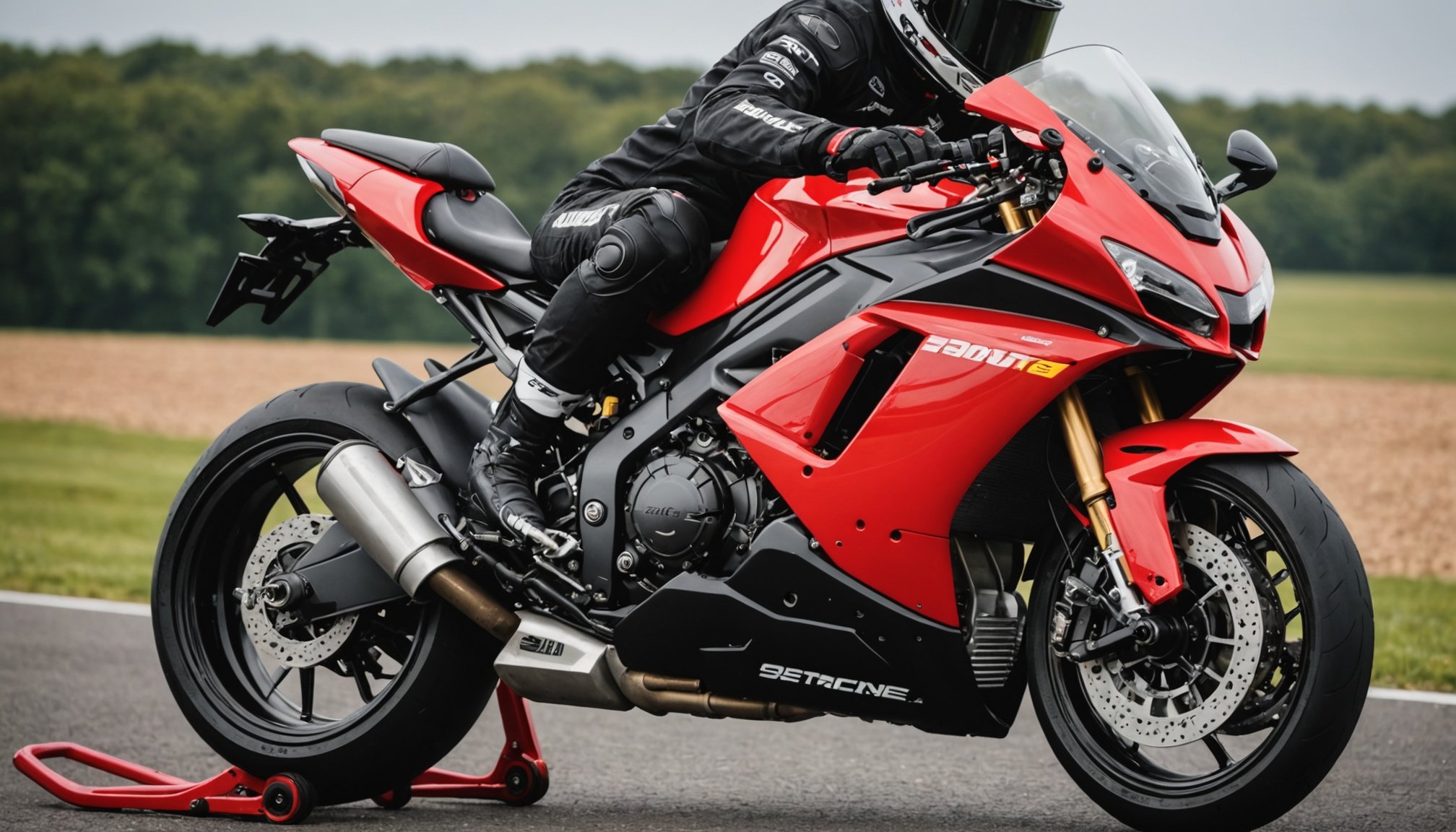Overview of Sport Bike Braking Systems
Understanding sport bike braking systems begins with recognising the essential components at play. The primary elements include the brake lever, master cylinder, brake calipers, brake pads, and brake rotors. When a rider engages the brake lever, hydraulic fluid within the master cylinder transmits pressure to the brake calipers, squeezing the brake pads against the brake rotors to halt the bike.
The braking performance of a sport bike is crucial, particularly in racing conditions where precision and reliability define outcomes. Superior braking performance enables riders to control their speed effectively, allowing them to navigate sharp turns with confidence and maintain a competitive edge. It can be the difference between a podium finish and a missed opportunity.
Also read : Mastering Chain Alignment for Your Sport Bike: Ensure Seamless Performance in UK Climate Conditions
Multiple factors influence the efficiency of the braking system. The material and condition of the brake pads, the size and type of brake rotors, and the overall weight distribution of the bike significantly impact the quickness and safety of stopping. For optimal performance, constant maintenance and occasional upgrades of braking components are vital to ensure maximum efficiency and safety on the track. A well-maintained braking system enhances performance and reduces the risk of accidents, providing riders with both confidence and control.
Types of Brake Upgrades
Upgrading your vehicle’s braking system can significantly enhance performance and safety. Different types of brake upgrades cater to varied driving needs and preferences.
Additional reading : Mastering Sport Bike Tire Inflation: Your Guide to Navigating the UK”s Changing Weather
Disc Brake Upgrades
Switching to larger or high-performance disc brakes can result in improved braking power and heat dissipation. These benefits are especially notable during high-speed or intense braking scenarios. Disc materials such as cast iron, carbon composites, and ceramic offer different performance attributes. Cast iron, commonly used, is durable and provides reliable performance. Carbon composites are lighter and excel at high temperatures, making them ideal for racing. Meanwhile, ceramic discs offer superior longevity and minimal noise, albeit at a higher cost. In the UK, regulations stipulate specific disc sizes, thus ensuring any upgrades remain compliant with these standards is crucial.
Brake Pad Enhancements
Brake pads play a pivotal role in braking efficiency. Organic, metallic, and ceramic pads each bring different benefits. For high-performance driving, brands like Brembo and EBC offer pads renowned for durability and superior stopping power. When installing new pads, properly bedding them in by gradually increasing brake pressure can help achieve optimal performance.
Upgrading Brake Lines
Replacing rubber brake lines with stainless steel braided lines enhances the brake feel and response. These lines resist expansion under pressure, leading to a more consistent and firm pedal feel. To ensure safety and maximum efficiency, follow best practices during installation, including properly torquing fittings and avoiding kinks in the lines.
Performance Impact of Upgrades
When evaluating the performance benefits of braking system upgrades, understanding how these improvements affect braking distance is crucial. One of the key changes is the reduction in the distance needed to bring a vehicle to a complete stop. This is particularly important in racing, where every millisecond counts. Components such as enhanced brake pads or rotors significantly shorten this distance, offering a competitive edge.
Additionally, heat management is a pivotal aspect of brake performance. Efficient heat dissipation allows the braking system to maintain its effectiveness under high-stress conditions. Without proper management, brakes can overheat, leading to reduced effectiveness and increased wear. This, in turn, can negatively impact the reliability and longevity of the braking system.
In racing scenarios, upgraded braking systems have shown remarkable improvements. For example, race cars equipped with advanced heat management technology and high-performance components demonstrate a considerable edge. They can endure prolonged high-speed conditions without compromising braking stability or efficiency. Upgrades in racing often trickle down to consumer vehicles, showcasing the tangible impacts of such enhancements not only on racetracks but also in everyday driving experiences. The precision and reliability gained from these upgrades ultimately contribute to safer and more controlled driving conditions.
Installation Tips and Best Practices
Braking efficiency and safety are paramount when considering brake upgrades. Whether you’re taking the DIY route or seeking professional help, knowing best practices and installation tips can make all the difference.
DIY Installation Considerations
For those opting to install aftermarket parts themselves, a step-by-step guide ensures smooth progress. Start by reviewing the manufacturer’s instructions thoroughly. Gather all necessary tools and, if possible, watch tutorial videos specific to your vehicle model.
Safety precautions are crucial. Always ensure the vehicle is on a stable, level surface, and use wheel chocks. Wear gloves and eye protection to avoid injuries. After the installation, test the brakes in a controlled environment to ensure they’re functioning correctly.
Be aware of common pitfalls in DIY brake upgrades. These include incorrect sizing of components and improper torque settings, which could lead to brake failure.
Professional Installation
Sometimes, professional expertise is necessary, especially if you lack the tools or experience for a safe installation. Knowing when to seek professional help can prevent costly mistakes and enhance safe braking.
During professional installation, expect a thorough approach ensuring all components fit properly and meet safety standards. Professionals offer the benefit of warranties, ensuring replacements if needed, and uphold standards that are crucial for vehicle safety and longevity.
Racing Track Regulations and Best Practices
In the thrilling world of motorsport, racing regulations are fundamental in shaping a fair and safe environment. Within the UK, these regulations are particularly important as they strictly monitor and impact various aspects, including braking modifications on racing vehicles. The primary aim of these regulations is to ensure track safety by stipulating standards that all braking systems must adhere to, preventing any unfair advantage while maintaining a safe environment for all competitors.
When it comes to braking best practices in competitive scenarios, racers need to be strategic. Effective braking not only involves selecting the right components but also requires understanding the dynamics of the track. Drivers should focus on mastering techniques such as trail braking, which allows for better control and speed management around corners. Regularly practicing these techniques can significantly enhance performance, ensure adherence to safety, and help in optimizing braking efficiency.
Equally critical is the ongoing maintenance of braking systems post-upgrades. This includes routine checks and fine-tuning to ensure components remain within the safety parameters set by racing regulations. Consistent maintenance helps in identifying potential issues early, prolonging the life of the braking components, and complying with the stringent but necessary safety standards necessary for racing.
Conclusion and Further Resources
The sport bike community provides invaluable insights and support for riders seeking to enhance their biking experiences. Engaging with this community not only connects you to fellow enthusiasts but also guides you to expert opinions and resources that can improve your understanding of braking performance and upgrades.
Discovering reputable forums and websites is essential. Some well-regarded platforms include Sportbikes.net and the Motorcycle.com forum, which offer advice, discussions, and shared experiences from riders worldwide. Participating in these forums grants access to real-world feedback and suggestions on braking techniques and enhancements.
For those interested in deepening their knowledge, several books and articles provide comprehensive information on braking performance. Notably, “A Twist of the Wrist” by Keith Code and “Total Control: High Performance Street Riding Techniques” by Lee Parks are essential reads. These materials explore modern techniques and safety considerations crucial for both novice and experienced riders.
Lastly, community feedback in racing contexts cannot be overstated. Riders often share invaluable tips and experiences that can make a difference in competitive environments. By participating actively in discussions, you foster an environment of mutual growth and learning, leading to more informed decisions and improved racing performance.






